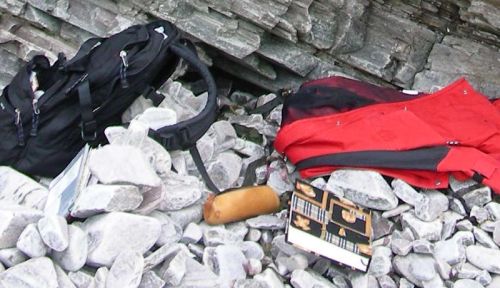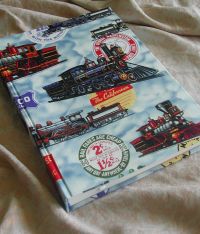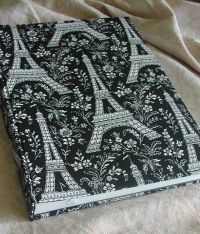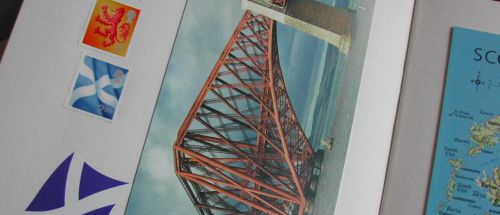|
Season 2009
|
|
|
|
|
|
In Times of Travelling
|
|
|
|
|
|
Your traveller's books will give you most pleasure once they have gone old. Reading them will revitalize memories you might have thought had gone completely lost. They haven't: images will come up, fragrances of foreign countries will be in the air, the sounds of far away forests will swing in your ears.
|
|
|
|
|
|
|
|
|
|
|
|
There are places without number where you can write down what you have seen or heard or gone through during your journey: on the ferry while it heads into dawn, in a caf‚ while having a good mug of tea, at the fireside with a glass of red wine, out on the cliffs, inside your campervan, in the tent with a full moon in the sky ...
And the best of it is: a neat handwriting is the least important in writing a traveller's book. You want to give your memories a shelter, want to keep all these little episodes that made you laugh or wonder, the fading moments, the conversation you overheard on the bus. These fainting experiances need to be pinned down onto the paper to prevent them from getting burried under the events of the next day that will bring more scenes and stories.
|
|
|
|
|
|

|
|
|
|
|
|
First of all your traveller's book is a companion. It will stay at your side whatever happens: heavy sea, maroding midges, diarrhoea, sandstorms, blood pudding ...
Ernest Hemingway is known to have had one, as well as the journalist Egon Erwin Kisch and many others. Who ever used a traveller's book knows: the older they become the more you will love them. And: if you watch out for a few wee little details the words written in your traveller's book will never fade.
|
|
|
|
|
|
|
|
|
|
|
|
It will come in handy if your book allows for tagged in bits and pieces such as postcards or dried flowers, restaurant bills and tickets that can go with your notes and sketches.
|
|
|
|
|
|
|
|
|
|
|
|
A cover made from fabric or cloth quite probabely will withstand the challenges of a journey better than one made of paper or even leather. Your book will accompany you on one or even a number of journeys. You will have to unpack it and put it away again and again. It will be placed here and there, on pebbles, on a tree trunk. There will come the moment when you stop bothering about wrapping your book into a plastic bag.
A cover made of paper will become fluffy, stains will sip in, if the book gets wet with rain or the odd spot of red wine on a restaurant table a paper cover will not resist this. Nor will leather as long as the book doesn't come from a shoemaker rather then a bookbinder.
|
|
|
|
|
|
|
|
|
|
|
|
A cover made from well chosen fabric or cloth will withstand quite a lot. One of my traveller's books with a cover made from a woolen fabric, got soaked during a downpour in Scotland (infact it was a very hot summer all in all, but there was this one moment of heavy rain). Over night I put the book on a table with as much weight on it as I could find. Next morning it had dried and at home you could not find the water had done any damage to the book - neither to the cover nor to the pages inside.
|
|
|
|
|
|
|
|
|
|
|
|
A good strong drawing paper makes a fine traveller's book. This paper will not tear easily even if you glue on postcards and the such, it will not crinkle when it gets wet or damp, or if it does it will straighten itself out when drying, you can erase pencils lines without doing any damage to the page and it will be equally good for writing, sketching, drawing and even watercolurs.
|
|
|
|
|
|
|
|
|
|
|
|
Rain and water are strong opponents. They will try to soak the cover and make the pages go all wavy. In these cases you quite certainly do not want your book to mutate into a portfolio of single sheets. Thus you better choose a sewn book.
The best you can use for writing outdoors is a medium soft pencil. The traditional sort of wooden pencil is best as you can sharpen it with your pocket knife at any time. But what is best about a pencil is: if you write on damp paper it will still work. And if what you have written becomes wet, the words won't float away. Pencil written words just stay on.
|
|
|
|
|
|
The collectingbooks have been designed to make your heavy duty companion giving you many options: writing, drawing, painting, sticking things in). Bookcovers are made from fabric with patterns related to travelling.
|
|
|
|
|
|
For those devoted to pilgrimage the pilgrim's books have been designed. The pages are made of fine Ingres deckle edge paper which can be used for writing and for all dry drawing techniques such as pastells or charcoal.
|
|
|
|
|
|
Those who want both a diary for their journey and a sketch book might find their traveller's book within the diary-series. The pages are made from Ingres deckle edge paper thus alongside the notes sketches and drawings can be made using pastells or chalks. The books come in portrait and in landscape format.
|
|
|
|
|
|
Feel free to browse the "Around-the-globe"-signpost to give you even more inspiration.
|
|
|
|
|
|
|
|





















